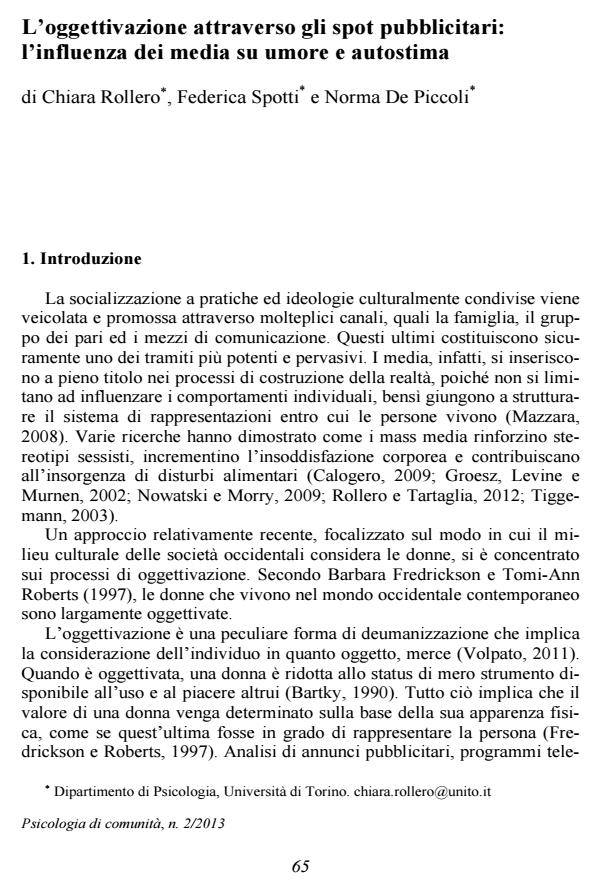L’oggettivazione attraverso gli spot pubblicitari: l’influenza dei media su umore e autostima
Titolo Rivista PSICOLOGIA DI COMUNITA’
Autori/Curatori Chiara Rollero
Anno di pubblicazione 2014 Fascicolo 2013/2 Lingua Italiano
Numero pagine 8 P. 65-72 Dimensione file 47 KB
DOI 10.3280/PSC2013-002008
Il DOI è il codice a barre della proprietà intellettuale: per saperne di più
clicca qui
Qui sotto puoi vedere in anteprima la prima pagina di questo articolo.
Se questo articolo ti interessa, lo puoi acquistare (e scaricare in formato pdf) seguendo le facili indicazioni per acquistare il download credit. Acquista Download Credits per scaricare questo Articolo in formato PDF

FrancoAngeli è membro della Publishers International Linking Association, Inc (PILA)associazione indipendente e non profit per facilitare (attraverso i servizi tecnologici implementati da CrossRef.org) l’accesso degli studiosi ai contenuti digitali nelle pubblicazioni professionali e scientifiche
L’oggettivazione costituisce una peculiare forma di deumanizzazione che si verifica ogniqualvolta un individuo viene considerato come oggetto, merce, corpo, ma non in quanto persona. La letteratura ha ampiamente evidenziato il ruolo decisivo giocato dai mezzi di comunicazione nel promuovere la cultura dell’oggettivazione. Il presente lavoro ha inteso approfondire gli effetti dell’esposizione a pubblicità oggettivanti, considerando eventuali cambiamenti sul tono dell’umore e sull’autostima. Hanno preso parte allo studio 154 studenti universitari (53.2% maschi). I risultati hanno mostrato che l’oggettivazione diminuisce l’umore positivo, ma l’effetto di tale processo è ancora più intenso quando le persone sono di fronte ad un modello oggettivato del proprio stesso sesso. L’oggettivazione femminile, inoltre, accresce l’autostima sociale degli uomini. Le implicazioni teoriche e di intervento vengono discusse.;
Keywords:Oggettivazione, pubblicità, tono dell’umore, autostima.
- Bartky S.L. (1990). Femininity and domination: Studies in the phenomenology of oppression. New York: Routledge.
- Birkeland R., Thompson J.K., Herbozo S., Roehrig M., Cafri G., Van den Berg P.
- (2005). Media exposure, mood, and body image dissatisfaction: an experimental test of person versus product priming. Body Image, 2: 53-61. DOI: 10.1016/j.bodyim.2004.11.00
- Calogero R.M., Thompson J.K. (2009). Potential implications of the objectification of women’s bodies for women’s sexual satisfaction. Body Image, 6: 145-148. DOI: 10.1016/j.bodyim.2009.01.00
- Capecchi S., Ruspini E. (2009). Media, corpi, sessualità. Dai corpi esibiti al cyber sex. Milano: Franco Angeli.
- Festinger L.A. (1954). A theory of social comparison processes. Human relations, 7: 117-140. DOI: 10.1177/00187267540070020
- Fredrickson B.L., Roberts T.A. (1997). Objectification Theory: Toward understanding women’s lived experience and mental health risks. Psychology of Women Quarterly, 21: 173-206. DOI: 10.1111/j.1471-6402.1997.tb00108.
- Gerbner G., Gross L., Morgan M. (2002). Growing up with television: Cultivation processes. In: Bryant J., Zillman D. (eds.), Media effects: Advances in theory and research (2nd ed., pp. 43-67). Mahwah, N.J.: Erlbaum.
- Grabe S., Hyde J.S. (2009). Body objectification, MTV, and psychological outcomes among female adolescents. Journal of Applied Social Psychology, 39: 2840-2858. DOI: 10.1111/j.1559-1816.2009.00552.
- Grabe S., Ward L.M., Hyde S.J. (2008). The role of the media in body image concerns among women: A meta-analysis of experimental and correlational studies. Psychological Bulletin, 134: 460-476. DOI: 10.1037/0033-2909.134.3.46
- Groesz L.M., Levine M.P., Murnen S.K. (2002). The effect of experimental presentation of thin media images on body satisfaction: A meta-analytic review. International Journal of Eating Disorders, 31: 1-16. DOI: 10.1002/eat.1000
- Harrison K., Cantor J. (1997). The relationship between media consumption and eating disorders. Journal of Communication, 47: 40-67. DOI: 10.1111/j.1460-2466.1997.tb02692.
- Heflick N.A., Goldenberg J.L. (2009). Objectifying Sarah Palin: Evidence that objectification causes women to be perceived as less competent and less fully human. Journal of Experimental Social Psychology, 45: 598-601. DOI: 10.1016/j.jesp.2009.02.00
- Johnson P.J., McCreary D.R., Mills J.S. (2007). Effects of exposure to objectified media images on men’s psychological well-being. Psychology of Men & Masculinity, 8: 95-102. DOI: 10.1037/1524-9220.8.2.9
- Mancini G.A., Russo V., Bellotto M. (2010). Psicologia della pubblicità. Firenze: Giunti.
- Mazzara B. (2008). I discorsi dei media e la psicologia sociale. Roma: Carocci.
- Moradi B., Huang Y. (2008). Objectification theory and psychology of women: a decade of advances and future direction. Psychology of Women Quartely, 32: 377-398. DOI: 10.1111/j.1471-6402.2008.00452.
- Nowatski J., Morry M.M. (2009). Women’s intentions regarding, and acceptance of, self-sexualizing behavior. Psychology of Women Quarterly, 33: 95-107. DOI: 10.1111/j.1471-6402.2008.01477.
- Rollero C. (2013). Man and women facing objectification: the effects of media models on well-being, self-esteem and ambivalent sexism. Revista de Psicologìa Social, 28.
- Rollero C., De Piccoli N. (2012). Modelli mediatici e oggettivazione maschile e femminile. Camera Blu, 8. Testo disponibile al sito: http: //www.tema.unina.it/index.php/camerablu/article/view/1631/1653. DOI: 10.6092/1827-9198/163
- Rollero C., Tartaglia S. (2012), Genere, ideologia e mass media: i differenti predittori del sessismo ambivalente. Psicologia di Comunità, 2: 119-128. DOI: 10.3280/PSC2012-00201
- Rollero C., Tartaglia S. (2013). Men and women at work: The effects of objectification on competence, pay, and fit for the job. Studia Psychologica, 55: 139-152.
- Tiggemann M. (2003). Media exposure, body dissatisfaction and disordered eating: Television and magazines are not the same! European Eating Disorders Review, 11: 418-430. DOI: 10.1002/erv.50
- Volpato C. (2011). Deumanizzazione. Come si legittima la violenza. Bari: Laterza.
- Ward L.M. (2003). Understanding the role of entertainment media in the sexual socialization of American youth: A review of empirical research. Developmental Review, 23: 347-388. DOI: 10.1016/S0273-2297(03)00013-
Chiara Rollero, L’oggettivazione attraverso gli spot pubblicitari: l’influenza dei media su umore e autostima in "PSICOLOGIA DI COMUNITA’" 2/2013, pp 65-72, DOI: 10.3280/PSC2013-002008